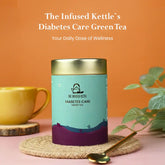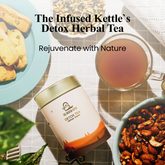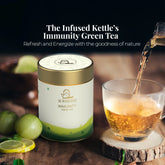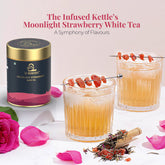Everything You Need To Know About Oolong Tea
When it comes to tea, most people are familiar with black and green varieties. The health benefits, the flavours, the global craze. it's all very well known. But there's another fantastic tea that often gets overlooked: Oolong tea. If you're a tea lover or simply curious about different types of tea, you’re in for a treat. Oolong tea is as amazing as its more famous cousins, and more people are starting to discover its unique charm. If you’re eager to learn more, keep reading because this blog will uncover everything you need to know about Oolong tea.
What is Oolong Tea?
-
The Meaning Behind the Name
The name Oolong comes from the Chinese word wūlóng, which translates to black dragon. This name refers to the dark, twisted appearance of the tea leaves, which can resemble the mythical dragon in Chinese culture. The leaves are usually long and curled, with a striking look that sets them apart from other teas.
-
Origins and History
Oolong tea has a rich history that dates back over a thousand years. It originated in China, primarily in the Fujian province, thanks to its ideal climate and fertile soil, where some of the best Oolong teas are still produced today. There are also significant Oolong tea productions in Taiwan, where the tea culture has flourished and evolved to create distinct varieties.
-
The Legend of Oolong
There are many stories about how Oolong tea got its name. One popular legend tells of a tea farmer named Wu Liang who was distracted by a deer while picking tea leaves. When he finally remembered the leaves, they had partially oxidized in the sun. Rather than discard them, he decided to process them, resulting in a tea with a unique flavor. This accidental discovery led to the creation of Oolong tea.
What Makes Oolong Tea Unique?
Oolong tea is often described as a tea that sits between green and black tea. This is because it undergoes a partial oxidation process, which gives it a unique flavour profile. Green tea is barely oxidized, preserving its fresh, grassy taste, while black tea is fully oxidized, resulting in a rich, robust flavor. Oolong tea, however, is partially oxidized, ranging from 10% to 80%. This partial oxidation creates a wide spectrum of flavours, from light and floral to deep and roasted.
One of the most captivating aspects of Oolong tea is its diverse range of flavors. Depending on how the tea is processed, you can experience a variety of taste notes in a single cup. Some Oolong teas have a delicate, floral aroma reminiscent of orchids, while others have a creamy, buttery taste. Then there are those with a nutty, toasty flavor that leaves a lasting impression. This variety is due to the different methods of processing and the terroir where the tea is grown.
-
The Craftsmanship Behind Oolong Tea
The production of Oolong tea is a meticulous process that requires great skill and experience. After the leaves are harvested, they are spread out to wither under the sun. This step reduces moisture content and makes the leaves more pliable. Next, the leaves are gently bruised to promote oxidation. This can be done by shaking the leaves in bamboo baskets or gently rolling them by hand.
The oxidation process is closely monitored, and the leaves are repeatedly rolled and rested until they reach the desired level of oxidation. Finally, the leaves are fired to halt oxidation and lock in the flavors. This intricate process not only defines the tea's taste but also its aroma and mouthfeel.
Is Oolong Tea Beneficial for Your Health?
The answer is yes! Like green and black tea, Oolong tea has its own unique set of health benefits that make it a wonderful addition to your daily routine.
Oolong tea is known to boost metabolism, making it a great ally in your weight loss journey. It helps your body burn fat more efficiently, which can aid in shedding those extra pounds. Additionally, Oolong tea improves digestion, reducing issues like acid reflux and promoting overall gut health.
If you care about your skin, Oolong tea supports healthy skin by fighting free radicals and reducing signs of aging. It also strengthens bones and teeth, thanks to its calcium, magnesium, and fluoride content.
How to Make Oolong Tea?
Making oolong tea is simple, but there are a few things to keep in mind to get the best taste and enjoy its benefits. Oolong tea is special because it's kind of like a middle ground between green and black tea. It has a unique flavor that you'll love once you get it right.
Start by using fresh, clean water and boil it. But don’t start pouring it right away! Let it cool down a bit to around 180-200 degrees Fahrenheit. This is important because too hot water can burn the tea leaves and make it bitter.
Next, you need to measure your tea. A good rule of thumb is about one teaspoon of loose-leaf oolong tea for every 6 ounces of water. But you can adjust this to your taste. Put the tea leaves in a teapot or infuser.
Now, it's time to pour the slightly cooled water over the tea leaves. Let it steep for about 3-5 minutes. The longer you steep, the stronger the flavor will be. But don't over-steep it or it will taste bitter.
Once the tea is ready, pour it into your cup. Remember, the key to good oolong tea is fresh leaves and the right water temperature. Experiment with different steeping times to find your perfect cup.
A Few Tips:
- Use good quality oolong tea. There are many different types, so experiment to find your favourite.
- Don’t reuse tea leaves. For the best flavor, use fresh leaves each time.
- If you like your tea stronger, you can steep it for a longer time or use more tea leaves.
- Experiment with different steeping times to find your perfect cup.
- Oolong tea can be enjoyed hot or iced.
Lost in the Tea Leaves? Choose The Infused Kettle's Classic Oolong
With a million and one tea brands flooding the market, picking the right one can feel like finding a needle in a haystack. Don't worry, tea lover! We've got you covered. Let's talk about The Infused Kettle's Classic Oolong.
The Infused Kettle isn’t just another tea brand. We’re passionate tea artisans who believe in bringing you the purest taste of nature. Our Classic Oolong is a testament to our commitment. Every leaf is handpicked and delicately processed to preserve its natural essence. It boasts a rich, complex flavor profile with a hint of floral sweetness, just like a little taste of paradise in every cup.
But it's not just about the taste. The Infused Kettle is committed to quality. We source the finest tea leaves from the heart of tea-growing regions. Plus, our packaging is designed to lock in freshness, ensuring you get the best cup every time.
Oolong tea is more than just a beverage; it's a journey of taste and well-being. With its rich flavour profile and numerous health benefits, it's no wonder this tea has captivated taste buds for centuries. And when you choose The Infused Kettle's Classic Oolong, you're opting for a tea that embodies quality, purity, and taste. Don't just take our word for it. Experience the magic yourself. Brew a cup, relax, and savor the moment. Your body and mind will thank you.
Related Posts:
Discover the World of Black Tea with The Infused Kettle
Roasted Chocolate Black Tea: Meaning, Benefits and Side Effects
The Infused Kettle's Apple Cinnamon Tea: A Symphony of Flavor and Wellness
Cutting Chai : Why Mumbai Loves Half Cutting Chai?
The Delicate Elegance of White Tea: A Comprehensive Guide
PCOS Tea Benefits: A Guide to Tea Wellness for Every Symptom
Green Tea: A Comprehensive Guide
FAQ's About Oolong Tea
Q. What is Oolong tea?
Ans: Oolong tea is a partially oxidized tea with a flavor profile between green and black tea. It offers a complex taste and numerous health benefits.
Q. How is Oolong tea different from Black tea?
Ans: Oolong tea is less oxidized than black tea, resulting in a milder flavor with a fruity or floral aroma. Black tea is fully oxidized and has a stronger, bolder taste.
Q. Can Oolong tea be taken with milk?
Ans: Yes, oolong tea can be enjoyed with milk. Many people prefer it without milk to appreciate its delicate flavor, but it's a matter of personal preference.
Q. How to prepare oolong tea?
Ans:
- Heat water to around 180-200°F (82-93°C).
- Use 1 teaspoon of tea leaves per 6 ounces of water.
- Steep for 3-5 minutes, adjusting time based on desired strength.
Q. Which is the Best Oolong tea?
Ans: If you're looking for a premium oolong tea that combines taste and quality, The Infused Kettle's Classic Oolong is definitely worth trying. Known for its commitment to purity and using only the finest tea leaves, it offers a delightful and authentic Oolong experience.







